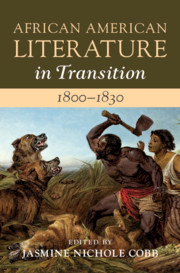Book contents
- African American Literature in Transition, 1800–1830
- African American Literature in Transition
- African American Literature in Transition, 1800–1830
- Copyright page
- Contents
- Figures
- Contributors
- Preface
- Chronology
- Introduction
- Part I Black Organizational Life before 1830
- Chapter 1 Race, Writing, and Eschatological Hope, 1800–1830
- Chapter 2 Daniel Coker, David Walker, and the Politics of Dialogue with Whites in Early Nineteenth-Century African American Literature
- Chapter 3 Black Entrepreneurship, Economic Self-Determination and Early Print in Antebellum Brooklyn
- Part II Movement and Mobility in African American Literature
- Part III Print Culture in Circulation
- Part IV Illustration and the Narrative Form
- Index
Chapter 3 - Black Entrepreneurship, Economic Self-Determination and Early Print in Antebellum Brooklyn
from Part I - Black Organizational Life before 1830
Published online by Cambridge University Press: 11 March 2021
- African American Literature in Transition, 1800–1830
- African American Literature in Transition
- African American Literature in Transition, 1800–1830
- Copyright page
- Contents
- Figures
- Contributors
- Preface
- Chronology
- Introduction
- Part I Black Organizational Life before 1830
- Chapter 1 Race, Writing, and Eschatological Hope, 1800–1830
- Chapter 2 Daniel Coker, David Walker, and the Politics of Dialogue with Whites in Early Nineteenth-Century African American Literature
- Chapter 3 Black Entrepreneurship, Economic Self-Determination and Early Print in Antebellum Brooklyn
- Part II Movement and Mobility in African American Literature
- Part III Print Culture in Circulation
- Part IV Illustration and the Narrative Form
- Index
Summary
This chapter examines the print culture that emerged from successes in black entrepreneurship in early nineteenth-century Brooklyn, New York. Through a close analysis of a newspaper notice, a city directory advertisement, and a patent, the author considers how three free Black men determined their own modes of political, economic, and cultural self-expression in spite of their oppression. Moreover, the chapter situates their economic protests into a larger contextual struggle. In the antebellum decades, Brooklynites, like many other early free Black communities across the North, pursued a variety of ways to secure their humanity. In Brooklyn, residents built their communities by establishing schools, churches, mutual aid societies, and businesses. Their activism resulted in vibrant and mobilized communities in areas known today as downtown Brooklyn, Williamsburg, Fort Greene, and Weeksville, New York (the second largest free Black community in pre-Civil War America).
Keywords
- Type
- Chapter
- Information
- African American Literature in Transition, 1800–1830 , pp. 71 - 90Publisher: Cambridge University PressPrint publication year: 2021

